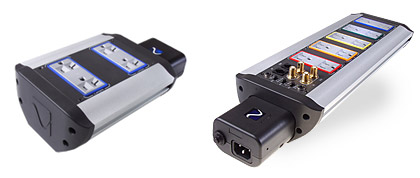PS Audio Quintet and Duet
| PS Audio Quintet and Duet |
| Superb AC Protection and Filtering in a Modern Modular Motif |
|
|
|
July 2007 |

The PS Audio Quintet is the heart of PS Audio’s latest generation of AC line protection and purification devices. Every new AC conditioning product that PS Audio currently markets contains a Quintet with either a “superfilter” (Quintessence) or power regenerator (Premier Power Plant) added to it; or in the case of the Duet, extra features and IsoZones™ outlets deleted from it.
IsoZones™ is a new technology that PS has incorporated into its new line of AC conditioning products. An IsoZone is a separate differential mode filter, fed by a common mode Nano Crystalline filter. In effect, each duplex outlet has its own dedicated, differential mode filter, to keep the components plugged into one IsoZone from feeding noise back into neighboring IsoZones. And that’s always a good thing.
PS Audio seems particularly proud of the modern styling of the Quintet and Duet. Indeed, their website literature proclaims: “The Duet and Quintet are housed in a gorgeous new chassis whose industrial design is based on the outsides of a BMW motorcycle and is the brainchild of one of our country’s brightest new ID talents, Chris Malato. The outer housing is extruded out of a solid half inch thick piece of aluminum, then machined and anodized into one of the best looking metal sculptures to ever grace a person’s home.”
I have to admit that the full beauty of these products did not hit me at first. But after reading the above, an idea slowly started to form—now stay with me on this. There are a lot of men, married men, to be more specific, who oft-times feel obligated when they buy a new toy for themselves, to purchase an item of equal value for their spouse. So here we have, in the Quintet, a modern sculpture that could become a classic. All we need do is kick in a little extra for an artsy pedestal and a custom Plexiglas cover and we have a magnificent artwork for her/him to display proudly in the foyer…
Suddenly, on a quiet romantic evening you hear an intruder fumbling with the door lock. You gracefully excuse yourself from your spouse’s gratuitous adulation and glide smoothly into the foyer. Just as the rascal breaks through your door you pounce. Chivalrously grasping the Quintet firmly by its Power Cartridge input module, you crack that sucker hard across the bridge of the nose. I’m telling you, that “perp” will rue the day he dared to darken your door, and you’ll come off looking like a hero.
Aside from all of the above, and with all due respect to designer Chris Malato, the Quintet you install in your system is still going to look awkward on the floor with all of its many cables shooting out of it vertically like a strange electro-mechanical octopus of some sort. I slyly managed to hide mine out of sight behind the equipment cabinet and you can do the same, but keep in mind that you will probably need to reach it periodically to push switches and plug and unplug components, so it should be at least semi-accessible.
Features
The Duet Power Center features 4 AC receptacles and 2 IsoZones, while the Quintet features 10 receptacles and 5 IsoZones. Both the Duet and Quintet have a fast acting circuit breaker, Nano Crystalline filter, Power Cartridge, and microprocessor-controlled under and over voltage surge protection. In addition, the Quintet has a power sequencer, CATV connectors, 12 volt DC triggers and telephone in and out protection. So considering that you get 6 additional outlets, 12-volt DC triggers plus dual phone line and cable TV/Internet protection for only $200 more, the Quintet would appear to be the better value.
Another Plus for the Quintet is that there are three, 3-position switches that control the way their respective outlets are turned on. The first position is “Always On,” and bypasses the blue power button for gear that you don’t want turned off (e.g., TIVO or 12-volt trigger device), while the second position is “Switched,” and turns gear on and off instantly with a push of the blue button. The third position is “Delayed,” which allows a 3-second time delay for power amps or components with larger current draws. All 3 sections can be configured independently, so you can “have it your way!”
Both the Duet and Quintet are rated at a robust 1750 watts output and in most cases will handle the entire current draw of a complete audio or home theater system with no compression or loss of dynamic capability. The quality of protection and noise reduction for both units is the same; so those who require a smaller, audio-only application where space is more limited may find the Duet to be the better fit.
The important things to remember are that these devices will effectively protect your valuable gear from common line surges and potentially damaging voltage spikes, while at the same time reducing AC interference and noise, thus improving the performance of your system in tangible ways that will be readily apparent.
Uh, hey guys, did you ever feel the urge to race home in the middle of a workday, during a torrential downpour to unplug your precious gear because you’d realized that there was a behemoth thunderstorm hovering over your part of town? Normally, I just cringe, pray, and hope for the best. But if your gear is protected by a PS Audio Quintet or Duet AC conditioner you can breathe easier while fantasizing about a mega-lightning bolt knocking out power to your workplace, forcing an early dismissal—then you can drive home and listen to some great music on your system.
Clear as Life/Plain as Day
I first installed the Quintet in my Home Theater system because I wanted to run my Comcast Cable TV and high-speed Internet connection through the Quintet’s sophisticated filters to see what kinds of improvements could be had. And since Arizona’s Monsoon Season is not far off, I want to protect my home theater system and my computer from potentially damaging surges and spikes caused by local thunderstorm activity. After all, I had lost two very good CD transports to power line surges the previous year.
Upon hooking up my TV, receiver, DVD player, etc., to the Quintet’s many isolated AC outlets, I fired up the TV just to see if I could notice a difference in picture quality. (Note that the PS unit replaced another company’s AC filtering device.) Because the Quintet contains 5 duplex IsoZone AC outlets, I was able to plug a single device into each of the 5 sections, thus taking full advantage of the inter-outlet isolation.
When the picture came up, my wife, Tina, commented immediately that the colors appeared more vivid. I thought so too, but was not fully convinced, just yet. So over the next couple of days I watched all my favorite channels (some HD, some basic digital, and some analog) so that I could better assess the change.
Truthfully, I believe the picture quality was even better the next day after allowing the Quintet to stabilize and begin to burn in. Indeed, reds seemed somehow redder, greens greener, and blues were bluer, though not in a sad sense. The picture was perkier, happier, better focused and more resolving. I could see more detail and minutia way back at the rear of the frames. Tiny things, off in the distance, were now clearer and more recognizable.
I was sure that my picture quality had taken a definite turn for the better. And considering that I was putting the cable through an additional piece of wire and more connectors, I was impressed. I also felt good about the protection factor, since we’d had a mild thunderstorm the previous evening.
 Later in the week, Tina and I watched Denzel Washington inDéjà Vu on DVD. I couldn’t get over how detailed and clear the projected street grids appeared in the ATF command center. Not only that, but the bass had become more extended, taut, and punchy. Watching Jaws on a Hi-def cable channel the next night confirmed the added bass virtuosity as the deep foreboding cello (or maybe double-bass) began its ominous mantra… indicating that the ferocious Great White was about to have another snack. This was definitely the clearest, most detailed picture, and the best sound (by far) that I had ever witnessed on Jaws. The Quintet’s enhanced sound and picture quality made the whole experience a lot more chilling and downright frightening (even though I’d seen the movie plenty of times). Thank you for that PS Audio!
Later in the week, Tina and I watched Denzel Washington inDéjà Vu on DVD. I couldn’t get over how detailed and clear the projected street grids appeared in the ATF command center. Not only that, but the bass had become more extended, taut, and punchy. Watching Jaws on a Hi-def cable channel the next night confirmed the added bass virtuosity as the deep foreboding cello (or maybe double-bass) began its ominous mantra… indicating that the ferocious Great White was about to have another snack. This was definitely the clearest, most detailed picture, and the best sound (by far) that I had ever witnessed on Jaws. The Quintet’s enhanced sound and picture quality made the whole experience a lot more chilling and downright frightening (even though I’d seen the movie plenty of times). Thank you for that PS Audio!
 The next evening, I decided to play the soundtrack CD Jersey Boys[Rhino R2 73271] in a surround format on my DVD player. After listening through the various songs on the CD, I was convinced that the audio from the system was the best it had ever been. There was an increase in focus from the low bass through the high treble. Like my video experience, the aural presentation was more lifelike and vivid. It was also a bit smoother and less harsh, especially in the high frequencies.
The next evening, I decided to play the soundtrack CD Jersey Boys[Rhino R2 73271] in a surround format on my DVD player. After listening through the various songs on the CD, I was convinced that the audio from the system was the best it had ever been. There was an increase in focus from the low bass through the high treble. Like my video experience, the aural presentation was more lifelike and vivid. It was also a bit smoother and less harsh, especially in the high frequencies.
Meanwhile, in my 2-channel system, I had just installed a new cartridge, the Benz-Micro Ebony L, in my Michell Orbe SE turntable. I had just finished tweaking all the adjustments and settings as good as I could get them, and truthfully, things were sounding quite good. I have to say that the Benz Ebony is an extremely well balanced and ultra-smooth sounding cartridge. But could it get better?
To answer that question, I installed the PS Audio Duet in the system. I plugged the turntable power supply into one bank and the phono stage into the other zone. Then I put on Ry Cooder’sBop Till You Drop LP, and sat back as I cued up “Little Sister.”
I can hardly describe the improvement I heard, but I’ll try. It was not subtle. Instruments and vocals became more immediate and had greater clarity. I heard distinct improvements in high-frequency extension and detail. The emerging music was more involving, intimate, and airy. In a word, it was “blissful,” and I hungrily gobbled down each and every savory note and nuance. It made me want to call Paul McGowan on the phone immediately and request a few more Duets and/or Quintets. After all, one cannot predict when an “uninvited rogue” might decide to drop in …

___________________
Manufacturer
PS Audio
4826 Sterling Drive
Boulder, CO 80301
PH: 720.406.8946
e-mail: service@psaudio.com
Web: www.psaudio.com
Quintet Features
(Courtesy of PS Audio)
Real surge protection
Nano Crystalline filters
Common Mode filtering
Differential mode filtering
Unimpeded AC power flow
10 Power Port AC receptacles
Solid aluminum chassis
Over under voltage protection
Solid copper delivery system
Delayed, switched outlet choices
Two 12 volt triggers
Two coax protection ports
Two phone protection ports
Real sonic improvements
Best filter performance
Complete surge and spike protection
Low resistance AC path
Superior noise reduction
Delayed turn on for proper startup
Protect satellite or TV as well
Quintet Price: $495.00
Duet Price: $295.00
![]()
Don’t forget to bookmark us! (CTRL-SHFT-D)
Stereo Times Masthead
Publisher/Founder
Clement Perry
Editor
Dave Thomas
Senior Editors
Frank Alles, Mike Girardi, Russell Lichter, Terry London, Moreno Mitchell, Paul Szabady, Bill Wells, Mike Wright, and Stephen Yan,
Current Contributors
David Abramson, Tim Barrall, Dave Allison, Ron Cook, Lewis Dardick, John Hoffman, Dan Secula, Don Shaulis, Greg Simmons, Eric Teh, Greg Voth, Richard Willie, Ed Van Winkle, Rob Dockery, Richard Doran, and Daveed Turek
Site Management Clement Perry
Ad Designer: Martin Perry





Be the first to comment on: PS Audio Quintet and Duet